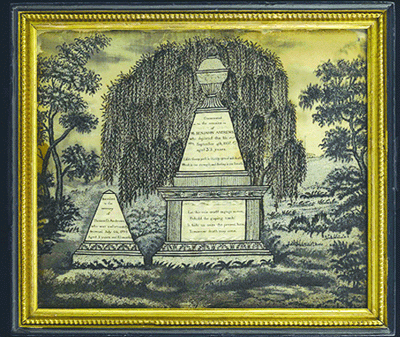19th century Neo-Classical explorations in whitework, print work
If you’ve never been to the American Folk Art Museum, I suggest cooling off there one afternoon this summer. Tucked next to the behemoth that is MoMA, the American Folk Art Museum is a slender column of poured concrete that houses five floors of pocket-sized galleries. Rather than restricting the curation, these small spaces have recently been home to a handful of smart, focused, and illuminating exhibitions including “Obsessive Drawing,” and “Tools of Her Ministry: The Art of Sister Gertrude Morgan,” as well as “Darger: The Henry Darger Collection,” now traveling the country.
The current exhibition, “White on White (and a little gray),” doesn’t disappoint, continuing the museum’s less-is-more approach. Consisting of only ten quilts and two small groupings of framed works, “White on White (and a little gray)” looks at the embrace of Neo-Classical ideals in the popular arts as practiced by 19th-century American women. The “whitework” bedcovers, drawn from the museum’s own collection, are whole cloth quilts whose monochromatic tops showcase exquisite designs made of embroidery, cording, and stuffing. For the 19th century viewer, the subtle light and shadow effects created by the low-relief needlework against the white cotton batting seemed to echo the refined lines, enlightenment and supposed “purity” of Greek sculpture. (It wasn’t until much later that archeologists discovered that Greek statuary was brightly painted in its original state.)
In the exhibition, the whitework bedcovers are hung vertically as paintings and softly raked with low light, making the room feel incredibly elegant and modern. It is only when we get close up to the quilts that we see or sense the hand-made and the vernacular.
The Neo-Classical is made even more human and colloquial in the collection of print works that bracket the quilts at one end of the gallery. Primarily made by schoolgirls and young women, print works were ornamental embroideries meant to be framed and hung on the wall. Unlike the usual cheerful sampler, print works were somber memorials that used tiny, black seed stitching to imitate the look of engravings, a popular art form at the time. Scenes included a collection of broken columns, steles and urns as well as the requisite ingenue, loins wrapped in diaphanous white robes and head bowed in mourning. The illustrations of Edward Gorey owe a great deal to the delicious naiveté and charm of these works.
Concluding “White on White (and a little gray)” is another group of monochromatic works referred to as Grecian Painting, or paintings made with marble dust. Again, these vernacular interpretations of the classical ideal and the imagined past were distinctly female. In 1835, Grecian Painting was introduced to American women by the book, “Artist, or Young Ladies’ Instructor in Ornamental Painting, Drawings, & c.,” by B.F. Gandee. Earnest, mannered copies of well-known contemporary images (Mount Vernon, Washington’s tomb, something called “Byron’s Dream”) were drawn in lampblack atop an iridescent surface of crushed marble. The tactile pairing of velvety charcoal and glittering, white marble dust allowed the artist to create seductive atmospheric effects, evoking both romantic moonlit scenes as well as Neo-Classical sculpture. One can easily imagine the sublime thrill of viewing these marble dust paintings in candlelight.
gaycitynews.com



































